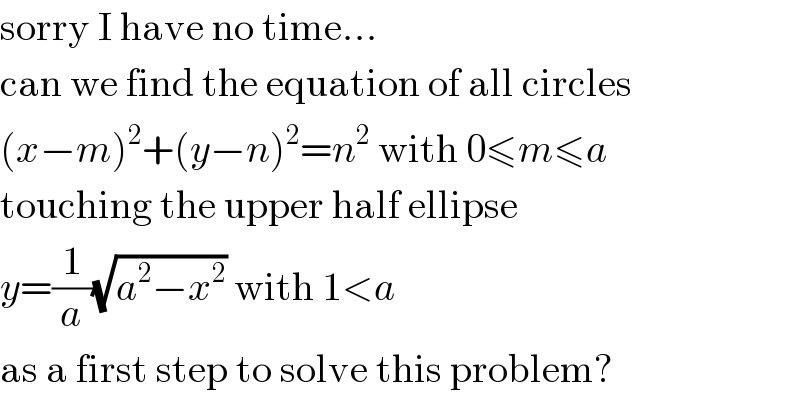
Question and Answers Forum
Question Number 125782 by ajfour last updated on 13/Dec/20

Commented by ajfour last updated on 13/Dec/20

Commented by MJS_new last updated on 14/Dec/20

Answered by mr W last updated on 14/Dec/20
![let μ=(b/a), λ=(r/a) say P(a cos θ, b sin θ) tan ϕ=−((b cos θ)/(−a sin θ))=(μ/(tan θ)) a cos θ=(√(((b/2)+r)^2 −((b/2)−r)^2 ))+r sin ϕ ⇒a cos θ=(√(2br))+((μr)/( (√(μ^2 +tan^2 θ)))) ...(i) b sin θ=r+r cos ϕ ⇒b sin θ=r[1+((tan θ)/( (√(μ^2 +tan^2 θ))))] ...(ii) (ii)÷(i): μ tan θ=((r[1+((tan θ)/( (√(μ^2 +tan^2 θ))))])/( (√(2br))+((rμ)/( (√(μ^2 +tan^2 θ)))))) let t=tan^2 θ μt=(((√λ)[1+(t/( (√(μ^2 +t^2 ))))])/( (√(2μ))+(((√λ)μ)/( (√(μ^2 +t^2 )))))) (√λ)[1+(t/( (√(μ^2 +t^2 ))))]=(((√λ)μ^2 t)/( (√(μ^2 +t^2 ))))+μt(√(2μ)) ⇒λ=((2μ^3 t^2 )/([1+(((1−μ^2 )t)/( (√(μ^2 +t^2 ))))]^2 )) ...(I) from (ii): ((μt)/( (√(1+t^2 ))))=λ[1+(t/( (√(μ^2 +t^2 ))))] ⇒λ=((μt)/( (√(1+t^2 ))[1+(t/( (√(μ^2 +t^2 ))))])) ...(II) ⇒[1+(((1−μ^2 )t)/( (√(μ^2 +t^2 ))))]^2 =2μ^2 t(√(1+t^2 ))[1+(t/( (√(μ^2 +t^2 ))))] ...(III) we can get t from (III) and then λ from (I) or (II).](Q125825.png)
Commented by mr W last updated on 14/Dec/20

Commented by mr W last updated on 14/Dec/20

Commented by mr W last updated on 14/Dec/20

Commented by ajfour last updated on 14/Dec/20

